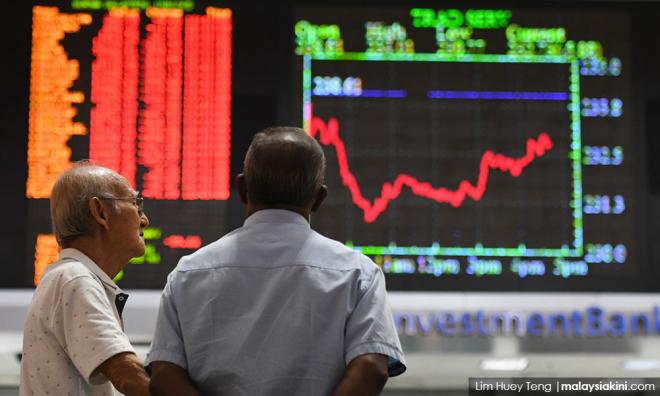
The economic downtown caused by the Covid-19 lockdown in Malaysia may be deeper and longer than many analysts are predicting and new data is signalling a worse picture than what was forecast by the government and Bank Negara when planning the current economic stimulus and recovery packages.
Official figures show that the Malaysian economy was already slowing down with economic growth for the first quarter falling to just 0.7 percent year-on-year. Growth fell by two percent compared to the previous quarter indicating that the recession had already started by the end of March 2020.
Up to the end of May, the market consensus from Bloomberg was forecasting a contraction of gross domestic product (GDP) of 2.7 percent in 2020, followed by stronger growth of 5.2 percent in 2021. Since then, new data from both Malaysia and our main global markets are turning the consensus downwards.
There are four main indicators behind this change. First the contraction in industrial production by 32.0 percent year-on-year defied the market forecast of a fall of 15.4 percent.
Second, the trade balance for April, which was expected to show a surplus of RM11.1 billion, ended in a deficit of RM3.5 billion. Exports had been expected to fall by 12.8 percent year-on-year but actually fell by 23.8 percent and imports were expected to fall by 15.6 percent but actually fell by only eight percent.
Third, the unemployment figures also took the steam out of market expectations coming in at five percent for April, the worst figures for 30 years and expected to continue at five to seven percent for the remainder of the year.
Finally, headline inflation had been expected to be negative 1.6 percent in April but instead fell to a deeper deflation of negative 2.9 percent. This pushes real interest rates to 4.9 percent wiping out the effects of the recent 50 basis point cut in nominal base rates.
Put simply, recent forecasts from official and market analysts have been too optimistic and the most recent official outcomes were twice as bad on the downside as had been expected. Upcoming data on domestic consumption, foreign and domestic investment and the trade balance are all expected to decrease significantly, adding to the gloomy scenario and signalling the need for a strong downward revision in our forecasts for the likely final outcomes.
Based on this new information our forecasts shift the downside risk toward a more dramatic recession with GDP falling 7.1 percent in 2020 and only a modest rebound of 3.6 percent in 2021 based on the current policy stance of the government and Bank Negara. It is uncertain whether Malaysia will return to the usual growth rates of four to five percent per year but if it does we do not expect to see this until 2022 at the earliest when we predict growth may touch 4.7 percent. The probable risk of deflation in 2020 completes the weak picture and we expect prices to fall by 2.5 percent during 2020 before returning to a more normal two percent inflation in 2021.

Our new forecasts are supported by revisions of market forecasters in the Bloomberg consensus poll. During June the consensus forecast began to turn downwards with half of the polling panel saying the economy will contract by 3.2 percent or more and some predicting a fall in GDP of eight to 8.5 percent. Among the policy bodies, the Asian Development Bank’s (ADB) most recent prediction is for a contraction of at least four percent in the Malaysian economy in 2020 before recovering to 6.5 percent in 2021. Deflation is also on the cards according to the ADB with prices falling by 1.5 percent this year.
These forecasts include the effect of four stimulus packages introduced by the Malaysian government since February. The estimated fiscal injection in terms of new cash that can flow into the economy immediately is about RM50 billion. This covers the main Prihatin and Penjana plans of March and June, the additional Prihatin funds in April and the earlier economic stimulus in February. Whilst this money is budgeted, it is yet to be seen whether it will actually find its way into the direct spending necessary to increase demand or whether it will be saved by cautious consumers or used by businesses to reduce debt.
We estimate that the government deficit will rise to nine percent of GDP and may increase further in line with the progression of the six-stage recovery plan. Nonetheless, the current stimulus is still too small if the economic contraction is as steep as the most recent data suggests.
An additional problem is that the stimulus money is mainly to support consumers and the survival of firms, is not directed toward re-establishing investment spending and competitiveness to sustain exports. This is a key concern because the current recession may have long-term implications due to the deep contraction of investment. We expect overall investment to contract by about 20 percent in 2020. Such a sharp decrease in investment is likely to cause a deterioration in the long-term growth potential of the economy, as we saw in 1997-8 when average growth rates fell from seven percent before to around five percent after the financial crisis.
Taking all this together an additional stimulus package involving a policy mix of monetary and fiscal policy is needed to accelerate the economy and improve Malaysia’s structural competitiveness in the post-Covid environment.
According to our forecasts, a forward-looking and proactive policy can limit the contraction to around 4.3 percent in 2020 and create a significant rebound of 8.4 percent in 2021 by stabilising the contribution of investment and eternal demand to GDP after a sharp contraction during the current recession. This will also end the likely deflation and provide a much-needed boost to jobs, income and demand.
The writers, Paolo Casadio, Hui Hon Chung & Geoffrey Williams are economists at HELP University based in Kuala Lumpur. - Mkini



No comments:
Post a Comment
Note: Only a member of this blog may post a comment.